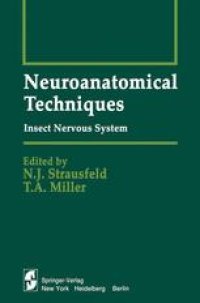
Ebook: Neuroanatomical Techniques: Insect Nervous System
- Tags: Zoology
- Series: Springer Series in Experimental Entomology
- Year: 1980
- Publisher: Springer-Verlag New York
- Edition: 1
- Language: English
- pdf
Most neurobiological research is performed on vertebrates, and it is only natural that most texts describing neuroanatomical methods refer almost exclusively to this Phylum. Nevertheless, in recent years insects have been studied intensively and are becoming even more popular in some areas of research. They have advantages over vertebrates with respect to studying genetics of neuronal development and with respect to studying many aspects of integration by uniquely identifiable nerve cells. Insect central nervous system is characterized by its compactness and the rather large number of nerve cells in a structure so small. But despite their size, parts of the insect eNS bear structural comparisons with parts of vertebrate eNS. This applies particularly to the organization of the thoracic ganglia (and spinal cord), to the insect and vertebrate visual sys tems and, possibly, to parts of the olfactory neuropils. The neurons that make up these areas in insects are often large enough to be impaled by microelectrodes and can be injected with dyes. Added to advantages of using a small eNS, into which the sensory periphery is precisely mapped, are the many aspects of insect behaviour whose components can be quan titized and which may find both structural and functional correlates within clearly defined regions of neuropil. Together, these various features make the insect eNS a rewarding object for study. This volume is the first of two that describe both classic and recent methods for neuroanatomical research on insect eNS.
Content:
Front Matter....Pages i-16
The Methylene Blue Technique: Classic and Recent Applications to the Insect Nervous System....Pages 1-14
Permanent Staining of Tracheae with Trypan Blue....Pages 15-19
Toluidine Blue as a Rapid Stain for Nerve Cell Bodies in Intact Ganglia....Pages 21-24
Demonstration of Neurosecretory Cells in the Insect Central Nervous System....Pages 25-50
Histochemical Demonstration of Biogenic Monoamines (Falck-Hillarp Method) in the Insect Nervous System....Pages 51-73
The Bodian Protargol Technique....Pages 75-95
Reduced Silver Impregnations Derived from the Holmes Technique....Pages 97-118
Reduced Silver Impregnations of the Ungewitter Type....Pages 119-130
The Golgi Method: Its Application to the Insect Nervous System and the Phenomenon of Stochastic Impregnation....Pages 131-203
Electron-Microscopic Methods for Nervous Tissues....Pages 205-239
Methods for Special Staining of Synaptic Sites....Pages 241-261
Experimental Anterograde Degeneration of Nerve Fibers: A Tool for Combined Light- and Electron-Microscopic Studies of the Insect Nervous System....Pages 263-281
Simple Axonal Filling of Neurons with Procion Yellow....Pages 283-290
Intracellular Staining with Fluorescent Dyes....Pages 291-306
Intracellular Staining of Insect Neurons with Procion Yellow....Pages 307-324
The Use of Horseradish Peroxidase as a Neuronal Marker in the Arthropod Central Nervous System....Pages 325-339
Cobalt Staining of Neurons by Microelectrodes....Pages 341-355
Nonrandom Resolution of Neuron Arrangements....Pages 357-372
Filling Selected Neurons with Cobalt through Cut Axons....Pages 373-402
Silver-Staining Cobalt Sulfide Deposits within Neurons of Intact Ganglia....Pages 403-427
Back Matter....Pages 447-496
Intensification of Cobalt-Filled Neurons in Sections (Light and Electron Microscopy)....Pages 429-446
Content:
Front Matter....Pages i-16
The Methylene Blue Technique: Classic and Recent Applications to the Insect Nervous System....Pages 1-14
Permanent Staining of Tracheae with Trypan Blue....Pages 15-19
Toluidine Blue as a Rapid Stain for Nerve Cell Bodies in Intact Ganglia....Pages 21-24
Demonstration of Neurosecretory Cells in the Insect Central Nervous System....Pages 25-50
Histochemical Demonstration of Biogenic Monoamines (Falck-Hillarp Method) in the Insect Nervous System....Pages 51-73
The Bodian Protargol Technique....Pages 75-95
Reduced Silver Impregnations Derived from the Holmes Technique....Pages 97-118
Reduced Silver Impregnations of the Ungewitter Type....Pages 119-130
The Golgi Method: Its Application to the Insect Nervous System and the Phenomenon of Stochastic Impregnation....Pages 131-203
Electron-Microscopic Methods for Nervous Tissues....Pages 205-239
Methods for Special Staining of Synaptic Sites....Pages 241-261
Experimental Anterograde Degeneration of Nerve Fibers: A Tool for Combined Light- and Electron-Microscopic Studies of the Insect Nervous System....Pages 263-281
Simple Axonal Filling of Neurons with Procion Yellow....Pages 283-290
Intracellular Staining with Fluorescent Dyes....Pages 291-306
Intracellular Staining of Insect Neurons with Procion Yellow....Pages 307-324
The Use of Horseradish Peroxidase as a Neuronal Marker in the Arthropod Central Nervous System....Pages 325-339
Cobalt Staining of Neurons by Microelectrodes....Pages 341-355
Nonrandom Resolution of Neuron Arrangements....Pages 357-372
Filling Selected Neurons with Cobalt through Cut Axons....Pages 373-402
Silver-Staining Cobalt Sulfide Deposits within Neurons of Intact Ganglia....Pages 403-427
Back Matter....Pages 447-496
Intensification of Cobalt-Filled Neurons in Sections (Light and Electron Microscopy)....Pages 429-446
....